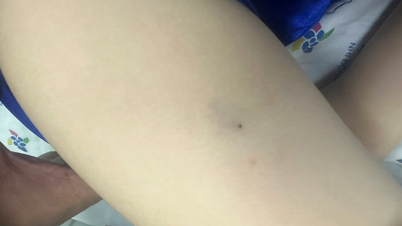
The mentality of "keeping it because you'll need it eventually" may seem normal at first glance, but it can actually be a sign of an increasingly common psychological disorder - Photo: The Paper
Old, torn clothes that you can't bear to throw away, piles of cardboard boxes from last year, snacks that are about to expire but still unopened... Have you ever seen these behaviors in yourself or your loved ones?
The "keep it because you'll need it eventually" mentality may seem normal at first glance. But it could actually be a sign of an increasingly common mental disorder.
Survival instinct or pathology?
According to an article analyzing this issue on The Paper , hoarding is a survival instinct of living things. Ants hoard food, squirrels hoard food - all for survival and better reproduction. Humans are no exception: children constantly buy toys without considering whether there is enough space in the house, adults continue to buy clothes even though their closets are full.
Being frugal and thrifty is to be encouraged, and a moderate amount of nostalgia is understandable. But when hoarding becomes an addiction and abnormal behavior appears, it can affect daily life and even develop into a mental illness.
In clinical medicine, this condition is known as "hoarding disorder" or "obsessive hoarding disorder" - figuratively known as "squirrel syndrome" (an animal that hoards food).
The progression from compulsive shopping to hoarding disorder is a slow one. Research shows that about 2 to 6 out of every 100 adults have hoarding disorder, and the condition often gets worse with age.
Remarkably, more than 70% of adults with hoarding behavior admit that the habit began before the age of 20, with the average age of onset even being as young as 12 years old.

For the items you have stocked up on, learn how to organize and store them, classify them by importance, and gradually dispose of unnecessary items - Photo: The Paper
4 diagnostic criteria for hoarding disorder
How can you tell the difference between simple shopping addiction and hoarding disorder? The main diagnostic criteria include:
Constantly hoarding things, regardless of how useful or valuable they are.
Feel extremely anxious or distressed when having to get rid of any hoarded items.
Hoarding behavior has affected normal life, causing overcrowding and chaos.
Hoarding behavior has affected social relationships, causing conflicts and arguments.
Hoarding behavior is not caused by another medical condition (such as brain damage or another mental disorder)
The average person may meet only one or two criteria. People with hoarding disorder often meet most of the above criteria. They often have multiple symptoms, such as anxiety, depression, impulsivity, and compulsion.
Hoarding disorder can stem from deep psychological causes, such as family influences, childhood trauma, or personal experiences, leading to a long-term lack of emotional comfort and a sense of security.
Recent research has found that people with attention deficit/hyperactivity disorder (ADHD) are more likely to hoard than healthy people. Nearly 50% of ADHD patients exhibit significant hoarding behavior.
Sufferers may often hesitate, have difficulty making choices, or have perfectionistic tendencies and separation anxiety - not wanting to be parted from familiar and close objects or people. Hoarding and keeping things can provide them with a sense of relaxation and satisfaction.
This disorder is more common in people who live alone, single people and the elderly. In fact, they are in great need of care and tolerance.

Hoarding disorder is more common in people who live alone, single people and the elderly - Photo: The Paper
Warning signs of hoarding disorder
If you notice that an elderly person in your home has started to hoard useless items, you should be checked for diseases such as Alzheimer's. Hoarding is not only a waste of money, but can also increase the risk of chronic diseases, bacterial infections, and falls and broken bones.
Experts recommend that both young and old people should regularly go out for walks, get some fresh air, talk to relatives, and open their "soul doors".
For the items you have stocked up on, learn how to organize and store them, classify them by importance, and gradually dispose of unnecessary items.
Of course, if it is really difficult to change, you should go to a professional medical facility to assess the severity of your symptoms and receive psychological treatment, or take medication when necessary, to improve your quality of life.
People with hoarding disorder need our understanding and professional help, not simple criticism.
Source: https://tuoitre.vn/chat-nui-do-trong-nha-can-than-chung-roi-loan-tich-tru-2025050219181683.htm


![[Photo] Vietnam shines at Paris International Fair 2025 with cultural and culinary colors](https://vphoto.vietnam.vn/thumb/1200x675/vietnam/resource/IMAGE/2025/5/4/74b16c2a197a42eb97597414009d4eb8)
![[Photo] General Secretary To Lam receives Sri Lankan President Anura Kumara Dissanayaka](https://vphoto.vietnam.vn/thumb/1200x675/vietnam/resource/IMAGE/2025/5/4/75feee4ea0c14825819a8b7ad25518d8)
![[Photo] Bus station begins to get crowded welcoming people returning to the capital after 5 days of holiday](https://vphoto.vietnam.vn/thumb/1200x675/vietnam/resource/IMAGE/2025/5/4/c3b37b336a0a450a983a0b09188c2fe6)



















































































![[Video]. Building OCOP products based on local strengths](https://vphoto.vietnam.vn/thumb/402x226/vietnam/resource/IMAGE/2025/5/3/61677e8b3a364110b271e7b15ed91b3f)




Comment (0)